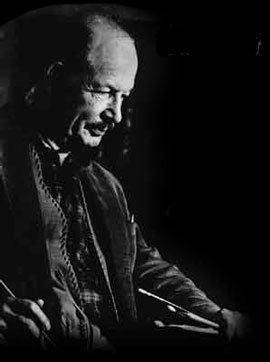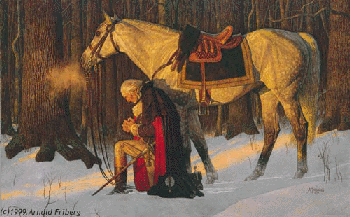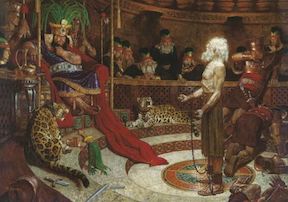Arnold Friberg
Arnold Friberg was an American artist born on December 21, 1913, in Winnetka, Illinois, son of a Swedish father and a Norwegian mother. At the age of three, Arnold moved to Arizona with his sister, Gertrude, and his parents. By age seven, young Friberg was already drawing original cartoons. Mr. Friberg remembers, "I never had to take an aptitude test, I always knew what I wanted to do, art."
The Fribergs were able to scrape together enough money to enroll Arnold in a correspondence course at the age of 10. While in Phoenix, Arizona, young Friberg often shared his drawings with the newspaper staff of the Arizona Republic and he learned from them. During his high school years, Arnold earned money by making signs for local businesses. After graduating from high school, he began his studies at the Chicago Academy of Fine Arts.
Friberg's favorite artist was Edwin Austin Abbey, who painted at the end of the 19th and beginning of the 20th century and painted Arthurian legends. His second favorite was Sir Lawrence Alma-Tadema, Cecil B. DeMille's favorite artist. Alma-Tedema traveled to museums in the ancient world. His paintings included the antiquities he found there, and he was famous in Hollywood for this authenticity and that of the historical costumes he painted.
Perhaps Friberg's most famous and popular patriotic work is his 1975 painting, "The Prayer at Valley Forge," a depiction of George Washington praying at Valley Forge, the site of the camp of the American Continental Army over the winter of 1777-1778 during the American Revolutionary War. Friberg is also well known for his fifteen previsualization paintings for the Cecil B. DeMille film "The Ten Commandments," used to promote the film worldwide.
He is a member of The Church of Jesus Christ of Latter-day Saints, for whom he did a series of paintings depicting scenes from the Book of Mormon.
Contents
Book of Mormon Paintings
Friberg was commissioned by then-General Primary President Adele Cannon Howells to create twelve illustrations of stories from the Book of Mormon, which have been heavily featured in Church literature and buildings.
- She was impressed by Friberg’s 1950 piece, “Pioneer Sunday School.” Motivated by a deep love for the Primary children, Howells personally commissioned Friberg to create the collection to mark the 50th year of “The Children’s Friend” magazine. The 12 paintings, $1,000 apiece, were scheduled to run each month during the magazine’s 50th year, although they ended up taking much longer.
- Friberg knew it would be a challenge.
- “It was a startling task to undertake, for the Book of Mormon had never been illustrated before, at least on any professional level,” Friberg wrote. “There were no precedents.”
- Howells arranged payment for the paintings on her death bed and passed before she could see a sketch.
- “Throughout all the painting days, the artist never forgot that Sister Howells’ last act on earth, the night she died, was to arrange for the sale of some property to pay for the project,” Friberg wrote. “She never lived to see even the first painting done, and it was the memory of her dedication that strengthened Friberg to push the series through to full realization. … For without her vision, her generosity, and her dogged determination, these paintings would never have existed.”
- Sister LaVern Watts Parmley succeeded Howells as the Primary general president and carried the project through to its completion. Howells’ family later donated the paintings to The Church of Jesus Christ of Latter-day Saints.[1]
The originals now hang in the Conference Center of the Church of Jesus Christ in Salt Lake City.
Painting for DeMille
In 1948 Friberg accepted a commission to do scenes of the American West for a calendar series by the Louis F. Dow Calendar Company. This would become the start of his serious interest in the West. By 1950 Arnold and his wife had moved to Utah, and Arnold started teaching commercial art at the University of Utah. It was while Friberg was teaching at the U of U that DeMille knew he had found his artist.
This led to the Fribergs move to Hollywood in 1953. There, Arnold worked with Cecil B. DeMille for over three years on The Ten Commandments as his chief artist and designer. Arnold worked closely with DeMille to visualize, through hundreds of sketches and paintings, a variety of scenes and human characters for the epic motion picture.
While his paintings are realistic and historically correct, it was Mr. Friberg's extraordinary ability to capture not only the drama of history, but also the vibrancy and inner strength of human characteristics that earned him the respect and recognition as one of the greatest master painters of modern times.
He was nominated for an Academy Award in 1957 for his work with DeMille.
Painting Prince Charles and Queen Elizabeth II
Friberg was commissioned by the Canadian government to paint HRH The Prince of Wales and his horse Centenial, a blue-blood thoroughbred the Canadian Mounties bequeathed England’s royal family. In 1990 Friberg was commissioned to paint a portrait of Queen Elizabeth II, also with Centenial. Both portraits were painted at Buckingham Palace.
- During the last sitting, on July 4, Friberg struggled to load film in his camera. Sensing his nervousness, the queen dismounted her horse to help.
- There they were, a Utah artist drawn to portraits and a British monarch born to rule, standing cheek to cheek examining a camera.
- “‘You see,’” Friberg remembers her saying, “‘you didn’t engage the sprocket. Now it will work.’ And she was right.”
- Just back from Canada, the queen later complained of jet lag, prompting Friberg to lodge his own gripe.
- “‘You’re making me work on our national holiday,’” he recounts. “‘I know what you’re doing. You’re getting even for Bunker Hill.’ And she laughed.”[2]
Friberg's Death and Legacy
Arnold Friberg was admitted as a lifetime member of the Royal Society of Arts. He died Thursday, July 1, 2010, at age 96 in Salt Lake City where he was convalescing from hip replacement surgery. [3]
True to the artist's desires, the Utah Cultural Arts Foundation will purchase all of the artwork Friberg possessed at the time of his death for the planned Arnold Friberg Museum of Art. The museum will be at a Utah location that is yet to be determined. The purchase agreement was signed at Friberg's home on June 21, 2010, the same evening he fell and broke his hip, the injury that led to his death. [4]
Opening in October 2013 and running through the end of the year, Friberg’s art was on exhibit at The Gateway in Salt Lake City. It was divided into 12 different sections: The Early Years, The Military, The Illustration Years, The Utah Years, The Hollywood Years, Bible in Art, Royal Canadian Mounted Police, The Royal Portraits, The Great American West, Patriotic Works, The Prayers at Valley Forge, and The Inspired Brush.
His Book of Mormon paintings have been displayed in the Book of Mormon gallery room at the Church’s Conference Center. “The Lost Book of Mormon Sketches” exhibit was on display in October 2013 at the Joseph Smith Memorial Building.
In 2021, the Brigham Young University Museum of Art purchased Friberg's "Peace, Be Still" (1960, oil on masonite 41 x 65 inches) with funds provided by Roy and Carol Christensen.
External Links
- Arnold Friberg Wikipedia
- See Arnold Friberg's paintings at FoundationArts.com
- A tour of Arnold Friberg's Book of Mormon paintings
- An anniversary exhibit
- Friberg's Book of Mormon Sketches
- Latter-day Saint Artists List
- ‘They’ll think I’m being measured for the guillotine’ — Utah LDS artist recalled painting Prince Charles and Queen Elizabeth
- Deseret News, "Insight into Arnold Friberg's Book of Mormon Paintings"


